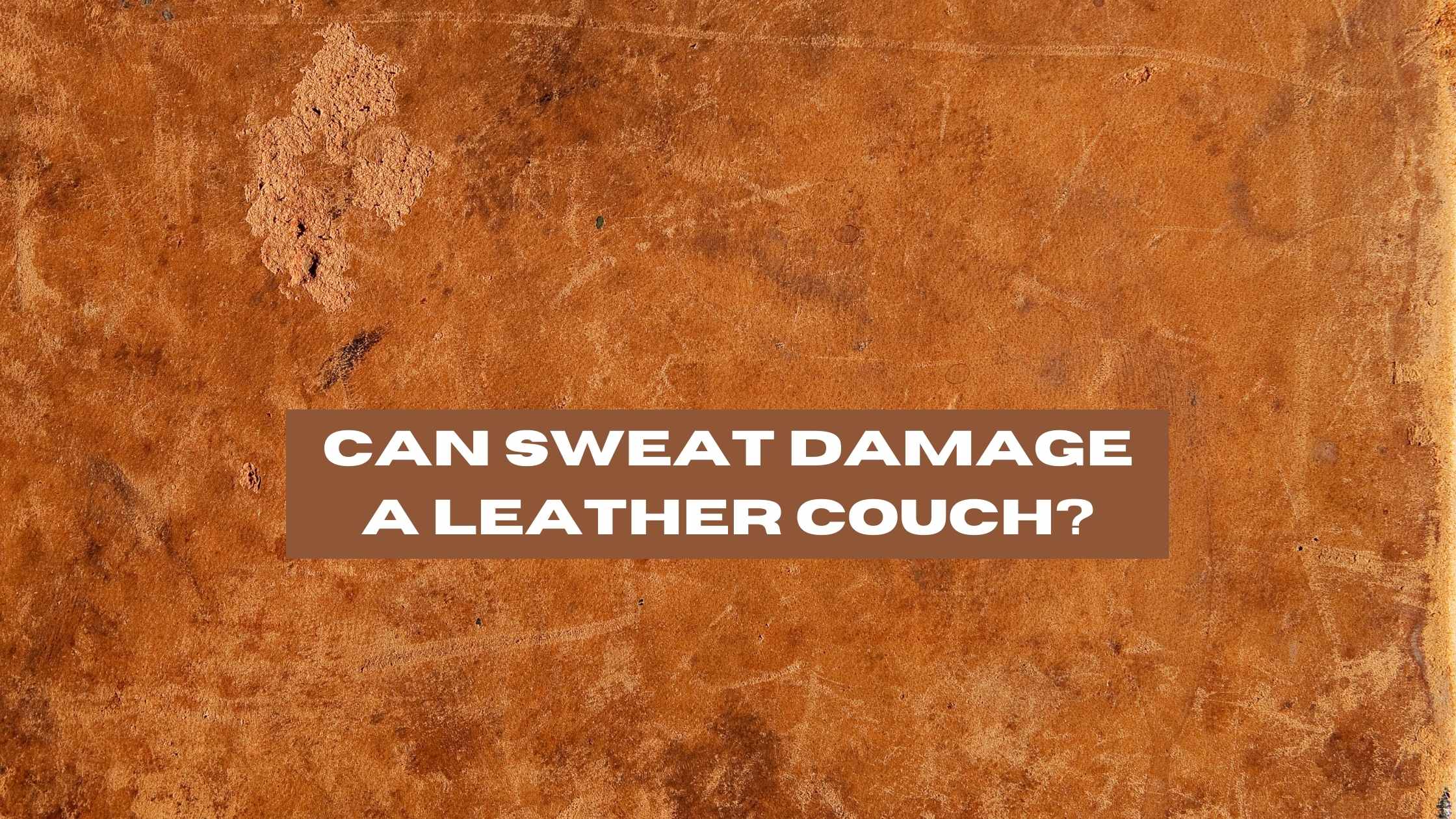Have you ever wondered if sweat can damage your leather couch? As comfortable and stylish as leather furniture may be, it’s essential to understand how to properly care for and maintain it to keep it looking its best. One concern many people have is the impact of sweat on their leather couches and for good reason. But can sweat damage a leather couch?
Yes, sweat can damage a leather couch by drying out the leather, causing it to crack, and fostering the growth of mold and mildew due to its moisture content. It’s important to protect and maintain the couch properly to prevent such damage.
Why Does a Leather Couch Make You Sweat?
In this section, we explore why a leather couch makes you sweat and discuss the main factors contributing to this phenomenon.
Leather Quality
Different leather qualities can influence how easily you sweat while sitting on a leather couch. If the leather is of low quality or synthetic, it may cause you to sweat more. Genuine leather has pores that allow for some degree of breathability, while synthetic leather materials can be less breathable and increase the chances of sweating.
To ensure more comfort and less chance of excessive sweating, focus on purchasing higher-quality leather furniture.
Material Type
The type of leather is another factor that affects whether you sweat or not. Chemically treated leathers or those with specific surface treatments can cause more sweat. In contrast, thicker, premium leather may be more breathable and cause less discomfort.
A Dirty Leather Couch
Regularly cleaning your leather couch is essential for maintaining its appearance and preventing any unpleasant sensations. A dirty leather couch can trap heat and cause your skin to sweat. This, in turn, can lead to the formation of mold, mildew, or permanent stains resulting from sweat, body oils, or dirt.
Therefore, ensuring your leather furniture is clean and well-maintained is integral to preventing sweat and avoiding damage to its surface.
The Impact of Sweat on Leather
Sweat can affect leather in various ways, such as causing discoloration, drying out the material, and leading to stains from sweat and body oils. Understanding these effects and taking the necessary precautions can help prolong the life of your leather couch.
Leather Discoloration
Sweat can cause leather to darken and become discolored over time. This is due to the salt and oils present in sweat reacting with the leather fibers, which can alter the color and appearance of your couch. To prevent sweat from discoloring your leather furniture, establish a regular cleaning routine using a pH-balanced leather cleaner to remove sweat and dirt gently.
Sweat and Oil Stains
Sweat and body oils can leave stubborn stains on leather surfaces. The acidity in sweat, with a pH level of around 4.5, can cause a reaction with the leather fibers, leading to unwanted marks. To remove stains, use a gentle leather cleaner that accommodates the difference in pH levels.
Moisture from sweat can also cause mold and mildew to develop, contributing to permanent stains. It’s crucial to prevent sweat and moisture from seeping into your leather couch. To keep the surface dry, promptly wipe away any liquid and consider using a vacuum to remove excess moisture from crevices.
How to Clean Sweat Stains Off Leather
First, it’s essential to know that sweat and body oils have a different pH level than leather, which could affect the leather fibers. To avoid unwanted reactions and damage, you should use a gentle cleaner designed specifically for leather surfaces. Check the product’s pH levels to ensure it aligns with leather’s typical pH range of 4.5-5.5.
Before you begin, vacuum the leather surface gently to remove dirt and dust. This will prevent any abrasives from causing further harm to the material. Next, dampen a clean microfiber cloth with your leather cleaner and wipe the affected area carefully. It’s essential to avoid soaking the leather with excess moisture, so use a minimal amount of liquid on the cloth. After wiping, let the cleaned area of the leather dry naturally.
If the stain still doesn’t budge, give a mix of equal parts water and white vinegar a shot. This concoction is known to tackle stubborn sweat stains effectively, but don’t forget to test it on a hidden part of the leather to prevent any unwanted reactions or harm.
Gently dab the solution onto the stain using a clean cloth, and then wipe it off with another clean, dry cloth. Take care not to scrub too vigorously, as you wouldn’t want to damage the leather fibers.
When you’ve finally gotten rid of the stain, it’s crucial to give some extra TLC to the cleaned areas. Go ahead and spread a leather conditioning cream over the entire piece of furniture to bring back its natural softness and durability. This magic potion also helps keep your leather looking immaculate, making future clean-ups a breeze.
Preventing Sweat Damage on Leather
To keep your leather furniture looking and feeling its best, it’s important to take preventive measures to protect it from sweat and body oils. In this section, we’ll discuss protective treatments, positioning and usage, and proper cleaning techniques to help you maintain your leather couch’s pristine condition.
Protective Treatments
One effective method to reduce the effects of sweat on leather is by applying a protective conditioning cream or protection cream to your piece of furniture. Not only does this add a layer of protection against moisture, sweat, and oil, but it also helps maintain the leather’s suppleness and prevents it from drying out.
Regularly applying a leather conditioner can make a noticeable difference in how much sweat can affect leather surfaces. Use a leather conditioning cream once or twice a year for optimal results.
Positioning and Usage
Another way to guard your leather furniture against sweat damage is by being mindful of where you place the item and how it is used. For instance, positioning the couch or chair away from heat sources and direct sunlight can prevent the leather from becoming overly dry, which makes it more susceptible to sweat and oil absorption.
Additionally, if you tend to sweat heavily while using the furniture, consider placing a towel, cloth, or washable sofa cover beneath you to create a barrier between your body and the leather surface.
Proper Cleaning
Regular cleaning can play a significant role in reducing sweat damage to your leather furniture. When sweat comes into contact with leather surfaces, it’s important to promptly remove any stains or moisture to prevent long-term damage. You can use a mixture of lemon juice and water to clean stains caused by sweat, while vinegar and dish soap solution can help remove discolorations.
It’s important to use gentle cleaning techniques and maintain appropriate pH levels in your cleaning solutions to avoid damaging leather fibers. Avoid using harsh chemicals or excessive scrubbing, as these can further weaken and degrade the leather’s surface.
Moreover, make sure to keep your leather furniture dry, as the residual moisture from cleaning solutions or sweat can encourage mold growth and cause permanent stains. Regular vacuuming and dusting can assist in keeping your leather clean and free from dirt and grime, further minimizing the risk of sweat damage.
Repairing Sweat-Damaged Leather
Leather is a luxurious and durable material, but it isn’t immune to the effects of sweat, which can cause damage over time. In this section, we’ll explore ways to repair sweat-damaged leather and prevent further damage from occurring.
DIY Solutions
To repair damage caused by sweat and body oils, you can try cleaning your leather couch using gentle household items. First, vacuum the surface to remove any accumulated dirt and dust. Then, mix a solution of equal parts water and white vinegar. This acidic mixture can help neutralize the effects of sweat while effectively cleaning leather surfaces.
Apply the solution to the affected area using a microfiber cloth and gently rub it in. Afterward, dry the area thoroughly with a clean cloth to prevent moisture from seeping into the leather fibers.
Another DIY solution to remove sweat stains is to create a paste of baking soda and water. Apply this mixture to the stained area, and let it sit for a few minutes before wiping it away with a damp cloth. This method is especially helpful for removing oil stains and absorbing unwanted liquids.
Professional Repairs
If damage from sweat has progressed beyond what you can manage with DIY solutions or the pH levels difference has caused a severe reaction in your leather furniture, it’s time to consider professional repair.
When it comes to fixing cracks, tears, or extensive stains, a skilled leather technician can provide the expertise and specific products needed to restore your leather couch to its former glory.
Regularly using leather cleaner and conditioning products can also help protect your leather from the damaging effects of sweat. By maintaining the leather’s pH balance and preventing it from drying out, these products can prolong your leather couch’s life and prevent costly repairs in the long run.
It’s essential to properly care for your leather seats, whether in your car or your living room. Quality leather materials should be less prone to sweat buildup, so investing in high-quality leather products can help. Additionally, applying a protection cream can create a barrier against sweat and other liquids, preventing damage from seeping into the leather fibers.
Preventing sweat damage on leather surfaces is achievable with regular upkeep and proper cleaning techniques. By paying attention to the moisture and stains that accumulate on your leather furniture, you can prolong its lifespan and maintain its beauty for years to come.

